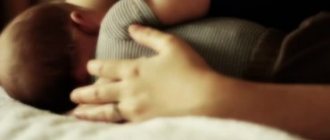Children's fears are almost always associated with unpleasant situations that are deposited in the baby's memory. If a child is afraid of water, then he has reasons for this. Only by eliminating them will you be able to cope with fear quickly. In newborns, bathing rarely causes discomfort, but in babies aged 2-3 years it often causes hysterics. Parents are interested in what to do in such a situation. They often make the mistake of forcing their child to perform a hygiene procedure against his will. Act gently to overcome fear and avoid psychological trauma.
Why is this happening?
There may be several reasons for such a child’s reaction to water. For example, a reluctance to dive into water can be preceded by bathing a child in too hot or, conversely, cold water. Also, sometimes such a reaction occurs in children after shampoo gets into their eyes. It is also possible that the child accidentally swallowed water during the last bath. There are also more complicated reasons. Sometimes children around two years old suddenly and for no apparent reason begin to be afraid of water. This is more due to the fact that children have a rich imagination, and they imagine that some kind of monster or something like that lives in the water.
Also, the reasons may be more hidden. A severe fear of water can arise from a certain internal discomfort of the child, which is associated with some events that took place in the family. However, such cases do not occur so often.
Be that as it may, you need to fight fear, but how?
Possible causes of hydrophobia in children 2-3 years old
Remember carefully, perhaps there was some incident related to water that you did not attach importance to, but in the baby this caused a whole storm of negative emotions in relation to water. He may have slipped in the bathtub, swallowed too much water, and is now afraid it might happen again.
Children often begin to feel afraid that soap or gel will get into their eyes - one precedent may be enough for this feeling to firmly settle in a small head. Perhaps you did not maintain the temperature balance while taking water procedures.
Alternative methods of dealing with childhood fears
One good method to combat the fear of water is dry bathing. This method does not involve bathing the child, but his gradual adaptation to the conditions in which he will bathe. Simply place a cloth in the bathtub to make it less slippery and place your baby in it. You can give him toys or invite him to play with water without bathing. Soon the baby will understand that there is nothing wrong with bathing.
This technique is effective because sometimes the cause of a child's fear is a large volume of water in the bath. In order to combat fear in a child, you can use another method. You can fill a hollow tub with water and let your child play with his toys there. Stories about the sea and its inhabitants also help. If you have a second child, you can bathe the children together. Sometimes it is easier for a child to get rid of fear when an older brother or sister shows him by example that bathing is not scary at all and is even fun. In addition to methods of dealing with fears, there are also mandatory rules that must be followed so that the situation does not become even worse. First, never laugh at your child's fears. Secondly, do not tell strangers in front of your child about his fear. This can only make the problem worse.
Overcoming fear in children under one year old
If a child begins to be afraid of water after six months, then it is worth approaching the mandatory hygiene procedure creatively. Organizing the bathing process for up to a year is not as difficult as it seems. The following tips can help on how to teach your child not to be afraid of water:
- There should be special devices in the bathroom of a fearful child. A rubber mat is required that will allow the baby to sit firmly. It is necessary from the moment the baby learns to sit.
- Most kids like an inflatable ring, a special hat and armbands.
- Bathing time should be increased gradually: from 5 minutes to half an hour.
- Carry out the procedure accompanied by calm and soothing music. This will distract the baby from the immersion process, calm the nerves, and prepare for sleep.
- Mom should be nearby, calm herself.
- If you did not keep an eye on the baby, and he was very frightened (slipped, made an unsuccessful attempt to get up, or hurt himself), stop taking a bath for 3-4 days. The incident will be forgotten, and after time the child will bathe calmly.
- A change of environment will help overcome persistent hydrophobia. Move the bath into the room and let dad bathe the child instead of mom.
Psychologists recommend being patient if a child is afraid to swim after the age of 6 months. If you are nervous, it will only make the problem worse. Protect your baby from stress and family conflicts.
You cannot hit the baby or shout at the baby: such behavior on the part of adults will make the phobia stable. In addition, you will harm the fragile body.
An infant does not drink water, is this normal?
Experienced pediatricians agree that infants should not be given water unnecessarily. Nature made sure that the child was fully provided with water. There is water in mother's milk. Therefore, sometimes you can notice that a child asks for the breast more often in the summer, but does not take it for a long time. This is due to the fact that the first milk that a child drinks is usually 90% water and this is more than enough to replenish the missing fluid in the body.
You should not compare children and adults. Children have a completely different diet and food is completely different. Adults are constantly thirsty because they eat foods that make them thirsty. For a child, it’s the other way around. It is also worth noting that the entry of water into the child’s body can increase pressure on the still undeveloped kidneys. It is often water that causes colic in a child. After all, it erodes the still very delicate microflora in the baby’s intestines. And if there is an excess of moisture in the body, the child poops water.
There is a fairly widespread stereotype that says that in the past children were given extra food, and this did not have a negative effect. However, this statement is not true, because previously children were fed on a schedule. But if a child started screaming an hour after eating, it meant that he was thirsty. The point here is more that at that time the composition of breast milk was not known, and it was believed that it should be washed down. The World Health Organization and the Ministry of Health have the same opinion on this matter. According to their recommendations, children under six months do not need to be given additional water unless there is a medical prescription for it. Therefore, now you won’t find children’s tea marked “from birth”; now you can find it marked “4 months from birth”.
Water surface
Treatments for children up to 6 months
Many people are surprised why a child is not afraid of water from birth. This is due to the fact that he spent the entire intrauterine period in liquid. This environment is understandable to him. From the very first days of life, a baby needs to be bathed. This procedure will bring pleasure, relieve tension from the spine, and improve digestion.
Sometimes newborns protest against hygiene procedures, then you can instill a love for water in different ways. One of them is recommended by our grandmothers - lower the child into the bath, wrapping him in a vest or diaper. Then the temperature and humidity of the body will change gradually. The cloth can be removed while washing the body.
If a child nevertheless begins to be afraid to bathe in the bathroom, then pediatricians recommend the following techniques for the first six months of life:
- Control the heating of the water. The bathroom must be warm if you want your child to swim for a long time.
- If your child becomes afraid of water, use a minimum amount of liquid. Separately keep warm water that you will use for your baby.
- Talk to your baby gently when bathing.
- If the child becomes afraid, change the towel. It should be soft, with a hood that securely covers your head. This option will avoid sudden temperature changes.
- There is a special technique for accustoming a child to water: first immerse the legs; if there is no crying, slowly immerse the whole body. Hold your head and make movements slowly. Place the bathtub at a comfortable height to safely protect your baby.
Up to 6 months, it is not difficult for a baby to overcome fear. If a child begins to be afraid to bathe after the age of 2-3 months, the following techniques will be useless: persuasion, distraction, play. The methods listed above are suitable for babies from the first days of life. They are aimed at creating a favorable environment so that the baby remembers his prenatal period.
In what cases do children still need to drink extra water?
Children who eat artificial formula are not included in the category of those who do not need water. Their diet consists of formulas that are difficult to digest, and they contain much less liquid than breast milk. If such children are not given enough water, they may develop problems with the gastrointestinal tract and constipation. Children should also be given water if you are feeding your baby. Especially if complementary foods are supplied in sufficient quantities. You can try giving water to a child over the age of six months and if he is thirsty, he will drink, and if not, then it means he does not need it. As a rule, babies do not drink water until they are eight months old. In any case, you should closely monitor the child and in no case allow dehydration.
What to do if your child is afraid of water
Parents, having discovered hydrophobia in their child, should first try to find out the cause and, if possible, eliminate it. For example, replace the shampoo and first check on yourself to make sure it really doesn’t burn your eyes, lay a beautiful children’s non-slip mat on the bottom of the bathroom, and don’t drain the water while the baby is still in the bath.
It is necessary to carefully monitor the water temperature, do not rely on the sensitivity of your hands, but use a thermometer. The temperature should be as comfortable as possible for the body and be 36-37 degrees.
But after eliminating the cause, the fear of water in children does not go away on its own in one day. Parents will need a lot of patience and imagination.
You should never force a child into water, scold him, laugh at his fear, shame him for crying, call him a slob and dirty. By such actions, parents further root fear and deeply wound the young soul. Adults must be correct and attentive. A frightened little man needs help and support. Criticism will not help here.
First of all, you need to understand that to overcome fear, any contact with water must be turned into a game.
Don't wait for an evening swim. During the day, when the child is in a good mood, you can take a small bowl, pour some water and tell the baby how his toys want to wash themselves. Wash the car together, wash the doll’s face, buy your favorite bunny. The toys are very happy, they like to bathe, they have fun and play with the baby.
Come up with different games with water that are not related to swimming. You can trust your mother’s assistant to spray and water the flowers or wash them together in the shower. On hot summer days, play with water pistols, draw pictures on the ground with a sprinkler.
The baby should experience joy from being in the water
Use different bath toys. Water mills, toys that sing when they touch water, floating wind-up toys, washable markers that can be used to draw directly on the tiles. All this can distract the child and help him forget fear.
Let the person choose their own bathing accessories. Today he wants a duck with ducklings or a boat, a small yellow sponge or a large red washcloth, to wash himself with baby soap or gel. Feeling in control instills confidence and courage.
Play with your little one, clap your hands on the water, learn to make waves, look for treasures at the bottom of the bathtub, blow soap bubbles. When the baby becomes bolder, you can learn to blow bulbs - dip your mouth and nose in water and blow out the air noisily.
Don't forget about songs and jokes about water and washing.
We pour warm water on our bird. Oh, water is on a duck's back, but thinness is on Alyonushka. Give me a diaper, wrap Alenka up.
Or:
Tap, open! Nose, wash your face! Wash both eyes at once! Wash your ears! Wash yourself, neck! Wash yourself, little belly, thoroughly! Wash yourself, Katya, shower yourself! Dirt, wash away! Dirt, wash away!
And after bathing, praise the baby, rejoice in his cleanliness:
Have you washed your nose? Washed. Did you wash your eyes? Washed. Have you washed your cheeks? Washed. And now we are clean, fluffy bunnies!
Don't overuse it. We were able to captivate the game for three minutes - while playing, we quickly washed ourselves and finished the procedure in a good mood. Next time he may agree to play longer. But always finish before he gets tired and remembers his fear.
If your child flatly refuses to take a bath, try running a baby bath or taking a shower. You can pour water on it from a watering can or jug. If he doesn’t even want to go into the bathroom, fill a basin and offer to bathe in the room.
Use any option that the child agrees to. The main goal is to ensure that he washes himself calmly, and only then you can gradually change the method and switch to a more convenient one. You can even give up bathing for several days (unless, of course, it’s summer outside and the child doesn’t sit in the sandbox for half the day) and wipe the child with a wet towel or wet wipes.
In any case, the most important thing in the fight against childhood hydrophobia is the patience of adults. Don't rush the baby. Help and support. A sensitive attitude and understanding of the little man’s problem will give the key to the lock of fear.
What should I give my child?
The child should be given clean water to drink. Options with juice or compote are extremely undesirable, since they do not provide any benefit to the body (at least for up to eight months). After eight months, you can try giving your child compote, but it must be diluted with water. And it’s better not to boil dried fruits for it, but to steam it and leave it in boiling water (this will preserve the vitamins in the compote).
You should not buy special baby water for your child. As a rule, ordinary purified water is hidden behind a loud name. Therefore, it is better to choose a reliable water supplier or buy bottled water. Moreover, it is also not recommended to boil this water, since after boiling it becomes dead. You must be confident in the water supplier and that it meets all standards. Children can also be given water after cleaning it with a good filter.
How much water should a child drink?
Until the child shows signs of dehydration, it is too early to panic. If a child refuses water, then it is likely that he gets enough of it from food. The source of hidden water can be fruits and vegetables or baby formula. And it is possible that the child drinks enough water during the day. In any case, there is no need to panic ahead of time, since the lack of water in the body does not go away without a trace; it is usually accompanied by dehydration. And if dehydration is not observed, it means the child has enough water.
Doctor Komarovsky's opinion
Dr. Komarovsky, on the issue of children’s fears of water, agrees with psychologists and pediatricians, who put the oversight or lack of education of mothers and fathers in first place among the causes of the problem.
The task of adults is to show the child how to build a relationship with water
In particular, the main mistake of parents is that they did not show how to love water, did not pay enough attention to building the baby’s relationship with it (too high/low temperature when taking a bath, sudden descent into the bath, etc.). If we talk about children aged 1–3 years, then the psychological comfort of the toddler plays a huge role. When a mother yells at the baby or parents quarrel, and all this precedes water procedures, then one should not be surprised that the child begins to refuse them: he is emotionally charged with negativity.
So, the mistakes have been recognized, analyzed, and it’s time to solve the problem. And here, Dr. Komarovsky, again, does not offer any unique techniques, but, like his other colleagues, offers a set of methods tested by more than one generation that will solve the problem, and your child will gradually get used to the water, and most importantly, will cease to be afraid of it .
Why do you dream about water?
Very often we see incomprehensible and strange things in our dreams, but why do we dream of water? First of all, the person who is interested in this will open the dream book. It’s difficult to understand why water is dreamed of, even with his help, everything is too figurative. But if you still dream about water and ask yourself this question, then you need to look for the answer in yourself. After all, a dream is your emotions, experiences, feelings. And in the case of such dreams, you are the root cause. Such a sign in a dream does not bring anything bad, it is especially good if you dream of clean water. It definitely means joy and the approach of something good. And if the water is dirty, then it’s worth understanding your experiences and premonitions, which it symbolizes. Now you know why you dream of water.
And more useful tips from friends
- Not all babies eat sand, but then it gets into its own eyes, nose, and ears, and sticks to toys. The child whines and gets angry, because he still doesn’t know how to shake himself off. The solution was to play near the water or with a bottle of water so that the sand could be washed away.
- An excellent toy is a watering can. It is good to water a child with it, even a very small one, so that he learns to hold his breath. First we pour it in front of the child so that he can see and understand what is happening. Then a second on his head.
- When a child is fussy, you can calm him down with your breasts right in the water. It’s not difficult to feed a little one while standing, but then the legs float away - and the well-fed child is already willing to splash in the water.
- You can jump in the water with your baby in your arms - the tension is immediately relieved and the fun begins. And when a mother runs into the sea with a child in her arms and screams of joy... But this is suitable if you also run with him on land - for example, after cats or pigeons.
- And with kids it’s great to gurgle into the water with your mouth.










